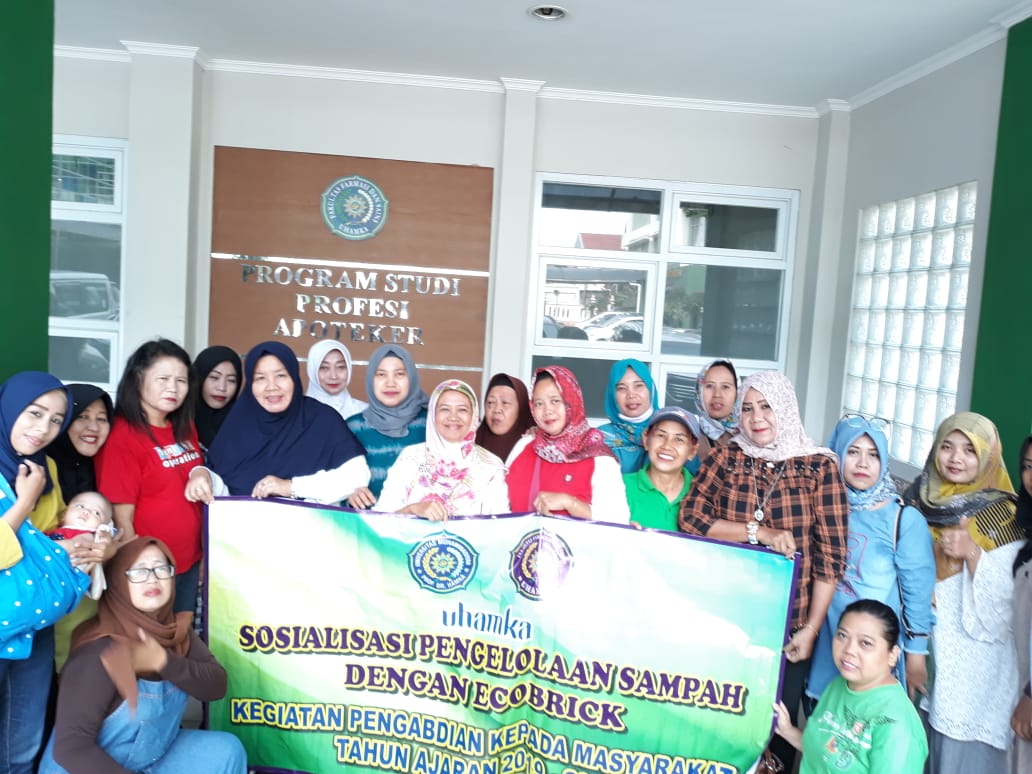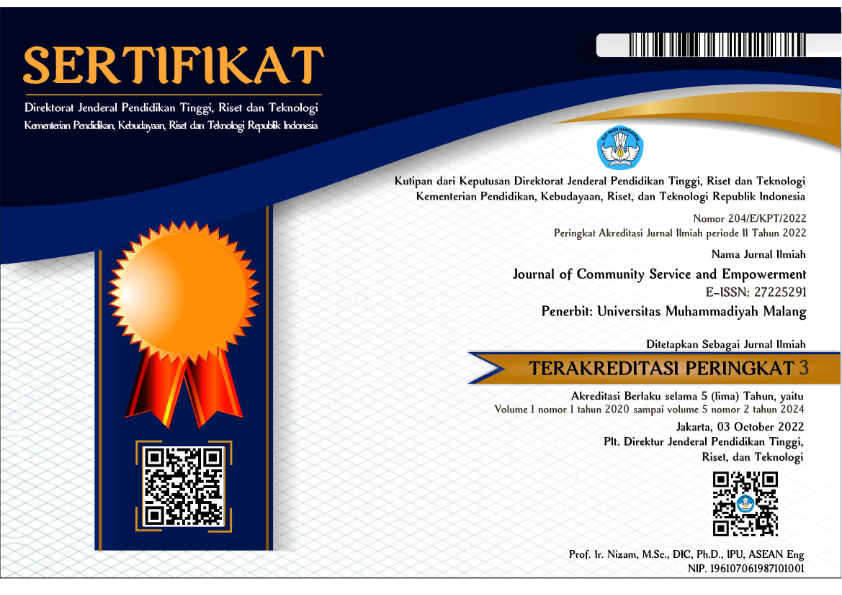Ecobrick as a smart solution for utilizing plastic and cloth waste in Jakarta
DOI:
https://doi.org/10.22219/jcse.v1i3.12250Keywords:
Cloth waste , Ecobrick , Plastic wasteAbstract
The problem of waste or garbage in large cities is also the focus of the Sustainable Development Goals (SDGs). This article aims to describe ecobrick activities as a solution to dealing with plastic and fabric waste in East Jakarta. The method used is empowerment by using several stages, namely the preparation stage and the implementation stage. Partners in this activity are women from RW 04 Perumnas Klender, East Jakarta, DKI Jakarta. Community service activities were carried out in March-April 2020. This service encourages partners to be actively involved, in the form of collecting various types of waste that have been determined, discussing materials, ecobrick techniques, and product manufacturing. To evaluate the activity, documentation is carried out in the form of attendance, photos, videos, and the resulting products. The service activities run according to plan, in the form of two stages, namely the preparation stage and the implementation stage (Socialization and explanation of plastic bottle and cloth waste, the impact on the environment and training in managing plastic bottle waste and leftover cloth into useful products). Partners are enthusiastic about participating in this “Ecobrick” activity and producing useful seat products. Partners can take their time to make this product. In addition to protecting the environment, this program also has added value for the community. The recommendation for the next program activity is training on marketing its products both conventionally and online, to deal with this pandemic condition.
Downloads
References
Adianti, I., & Ayuningtyas, N. V. (2020). Pelatihan pembuatan ecobrick kepada anak-anak siswa SD Kanisisus Kembaran, Bantul, Yogyakarta. Jurnal Ilmiah Padma Sri Kreshna, 2(1), 1–8. https://doi.org/10.37631/psk.v2i1.121
Alabi, O. A., Ologbonjaye, K. I., Awosolu, O., & Alalade, O. E. (2019). Public and environmental health effects of plastic wastes disposal: A review. Journal of Toxicology and Risk Assessment, 5(1), 021. https://doi.org/10.23937/2572-4061.1510021
Andriansah, A., Setiawan, F., Logiansyah, D., Alexander, F., Safitriani, L., Ariani, A. P., Marlina, S., Widiya, V., Natasya, Y., & Pramudita, I. (2020). Pelatihan pengolahan limbah plastik melalui paving block dan ecobrick di Desa Sri Pengantin Kecamatan STL Ulu Terawas. Communnity Development Journal, 1(3), 296–300.
Antico, F. C., Wiener, M. J., Araya-Letelier, G., & Retamal, R. G. (2017). Eco-bricks: A sustainable substitute for construction materials. Revista de La Construccion, 16(3), 518–526. https://doi.org/10.7764/RDLC.16.3.518
Apriyani, A., Putri, M. M., & Wibowo, S. Y. (2020). Pemanfaatan sampah plastik menjadi ecobrick. Masyarakat Berdaya Dan Inovasi, 1(1), 48–50.
Damanhuri, E., & Padmi, T. (2010). Pengelolaan sampah. Institut Teknologi Bandung.
Ecoist. (2019). Plastic waste exchanged for cryptocurrency. News. https://www.ecoist.life/en/news/2248#:~:text=The biggest feature of Plastic,collectors to make their livings.
Fauzi, A. R., Ichniarsyah, A. N., & Agustin, H. (2016). Agricuture: Urgency, role, and best practice. Jurnal Agroteknologi, 10(1), 49–62.
Istirokhatun, T., & Nugraha, W. D. (2019). Pelatihan pembuatan ecobricks sebagai pengelolaan sampah plastik di RT 01 RW 05, Kelurahan Kramas, Kecamatan Tembalang, Semarang. Pasopati, 1(2), 85–90. https://ejournal2.undip.ac.id/index.php/pasopati/article/download/5549/3111
Jalaluddin, M. (2017). Use of plastic waste in civil constructions and innovative decorative material (Eco- friendly). MOJ Civil Engineering, 3(5), 359–368. https://doi.org/10.15406/mojce.2017.03.00082
Jupri, A., Prabowo, A. J., Aprilianti, B. R., & Unnida, D. (2019). Pengelolaan limbah sampah plastik dengan menggunakan metode ccobrick di Desa Pesanggrahan. Prosiding PEPADU, 1(1), 341–347.
Maier, R., Angway, I., & Himawati, A. (2017). Plastik, lingkungan, dan ecobricks. Ecobricks.org.
Maier, R., Angway, I., & Stodgel, J. (2015). Panduan visi ecobrick. Ecobricks.org. http://www.google.com/url?sa=t&rct=j&q=&esrc=s&source=web&cd=3&ved=0ahUKEwijzPnDg53aAhWKNI8KHXO_AjsQFgg4MAI&url=http%3A%2F%2Fwww.ecobricks.org%2Fwp-content%2Fuploads%2F2016%2F04%2FPanduan-Visi-Ecobrick-v3.2.pdf&usg=AOvVaw3bzs1M6ogEq356v-GwOZ2I
Marpaung, G. S., & Widiaji. (2009). Raup Rupiah dari Sampah Plastik. Pustaka Bina Swadaya.
Mazhandu, Z. S., Muzenda, E., Mamvura, T. A., Belaid, M., & Nhubu, T. (2020). Integrated and consolidated review of plastic waste management and bio-based biodegradable plastics: Challenges and opportunities. Sustainability (Switzerland), 12(20), 1–57. https://doi.org/10.3390/su12208360
Meiliani, M. (2020). Foto: Ancaman limbah kain di balik industri busana. Kumparan. https://kumparan.com/kumparannews/foto-ancaman-limbah-kain-di-balik-industri-busana-1srGXOIn9v4/full
Nasir, M., Fatkhurohman, F., & Muqorobin, A. (2011). Problem manajemen lingkungan dan isu industrialisasi. Prosiding Seminar Nasional & Internasional, 1(1), 163–172. https://jurnal.unimus.ac.id/index.php/psn12012010/article/view/420
Pamungkas, T. A., & Iswanto. (2006). Bukan Membuang tapi Mengelola, dalam Sampah Dilema Manusia Modern dan Krisis Ekologi. Balairung Jurnal Mahasiswa Universitas Gadjah Mada, 39.
Papineschi, J., Hogg, D., Chowdhury, T., Durrant, C., & Thomson, A. (2019). Analysis of Nordic regulatory framework and its effect on waste prevention and recycling. Nordic Council of Ministers. https://doi.org/10.6027/TN2019-522
Rahmatulloh, R. (2017). Dinamika kependudukan di ibukota Jakarta (Deskripsi perkembangan kuantitas, kualitas dan kesejahteraan penduduk di DKI Jakarta). Genta Mulia, 8(2), 54–67.
Rhodes, C. J. (2018). Plastic pollution and potential solutions. Science Progress, 101(3), 207–260. https://doi.org/10.3184/003685018X15294876706211
Ridwan, T., & Lamboka, F. (2020). Intip cara Anies kelola sampah di Jakarta. Antaranews.Com. https://www.antaranews.com/berita/1266839/intip-cara-anies-kelola-sampah-di-jakarta
Song, J. H., Murphy, R. J., Narayan, R., & Davies, G. B. H. (2009). Biodegradable and compostable alternatives to conventional plastics. Philosophical Transactions of the Royal Society B: Biological Sciences, 364(1526), 2127–2139. https://doi.org/10.1098/rstb.2008.0289
Sudrajat, H. (2006). Mengelola sampah. Niaga Swadaya.
Sumastuti, E., Setyorini, N., & Gultom, H. C. (2018). Ecobrick sebagai solusi pengelolaan limbah plastik di Kelurahan Bendan Ngisor Kecamatan Gajahmungkur Kota Semarang. Proceeding SNK-PPM, 1, 1–5.
Suminto, S. (2017). Ecobrick: Solusi cerdas dan kreatif untuk mengatasi sampah plastik. Productum: Jurnal Desain Produk (Pengetahuan Dan Perancangan Produk), 3(1), 26–34.
Susilo, R., & Karya, A. (2012). Pemanfaatan limbah kain perca untuk pembuatan furnitur. Jurnal Tingkat Sarjana Senirupa Dan Desain, 3(1), 1–6.
Westerbos, M. (2019). Sustainable Development Goals and fighting the plastic soup. IMPAKTER. https://www.plasticsoupfoundation.org/en/2019/03/sustainable-development-goals-and-fighting-the-plastic-soup/
Widyastuti, R. A. Y. (2019). Susi curiga industri tekstil sengaja buang limbah kain ke laut. Tempo.Co. https://bisnis.tempo.co/read/1237479/susi-curiga-industri-tekstil-sengaja-buang-limbah-kain-ke-laut
Wojnowska-Baryła, I., Kulikowska, D., & Bernat, K. (2020). Effect of bio-based products on waste management. Sustainability (Switzerland), 12(2088), 1–12. https://doi.org/10.3390/su12052088
Zuhri, T. S., Cahyanti, E. T., Alifa, E. F. A., & Asyfiradayati, R. (2020). Daur ulang limbah sampah melalui metode ecobrick di Desa Jatisari, Kecamatan Sambi, Kabupaten Boyolali. The 11th University Research Colloquium 2020, 229–236.

Downloads
Published
How to Cite
Issue
Section
License
Copyright (c) 2020 Yusuf et al

This work is licensed under a Creative Commons Attribution-ShareAlike 4.0 International License.












